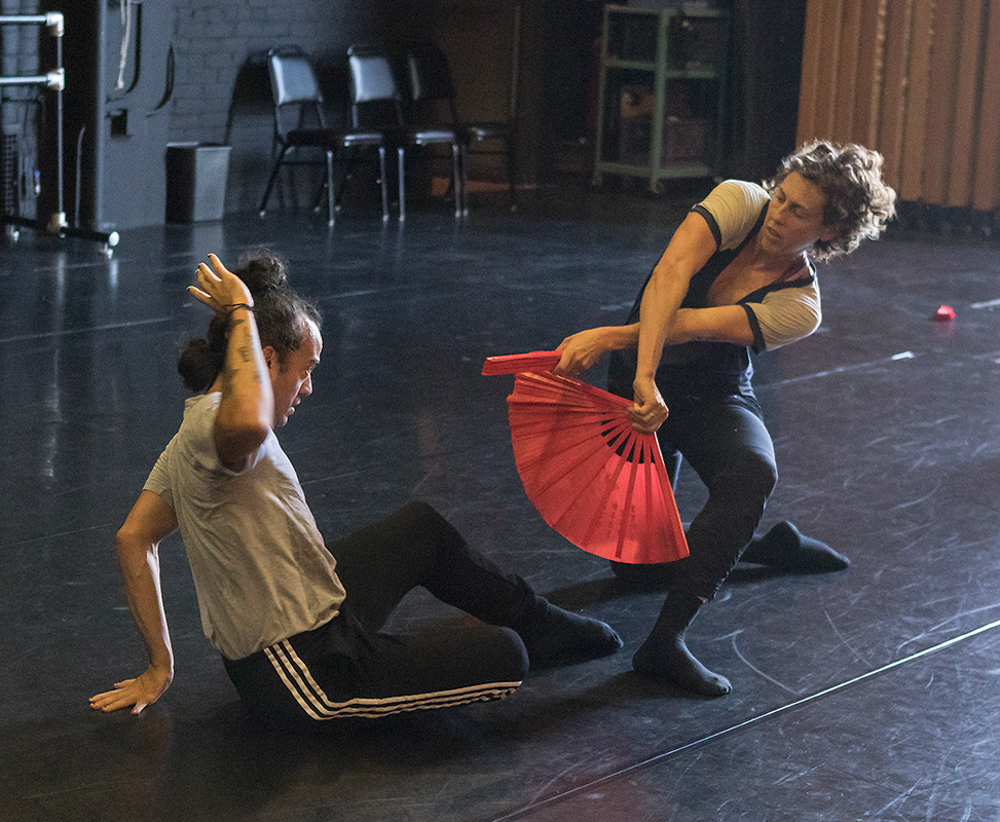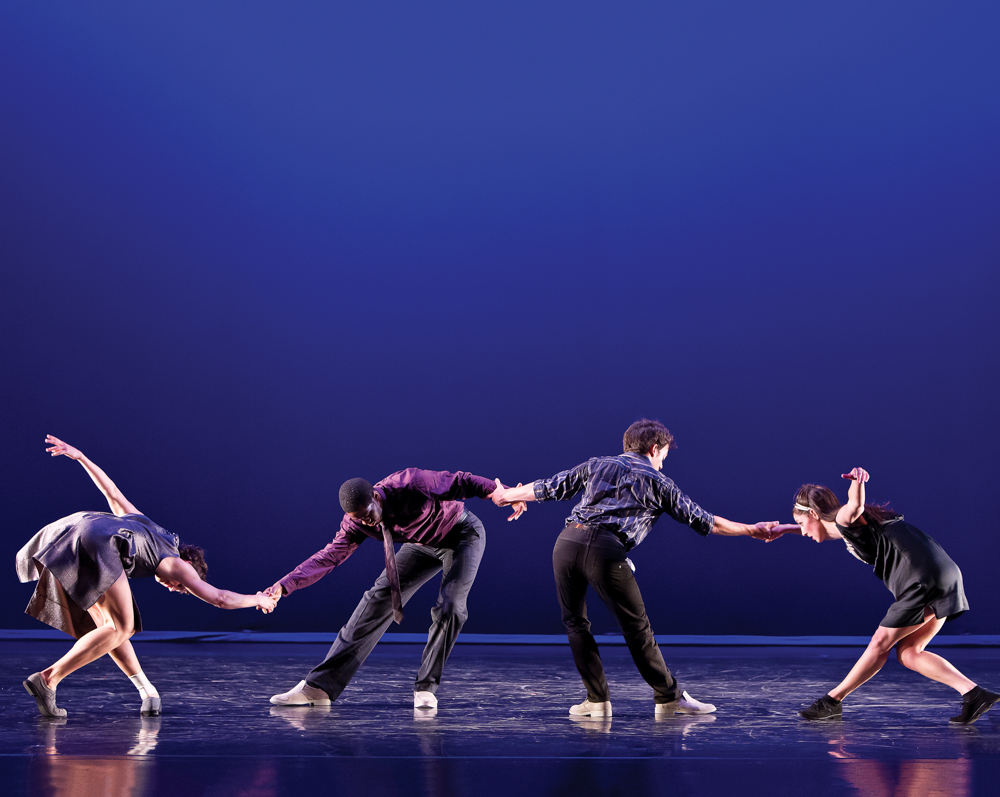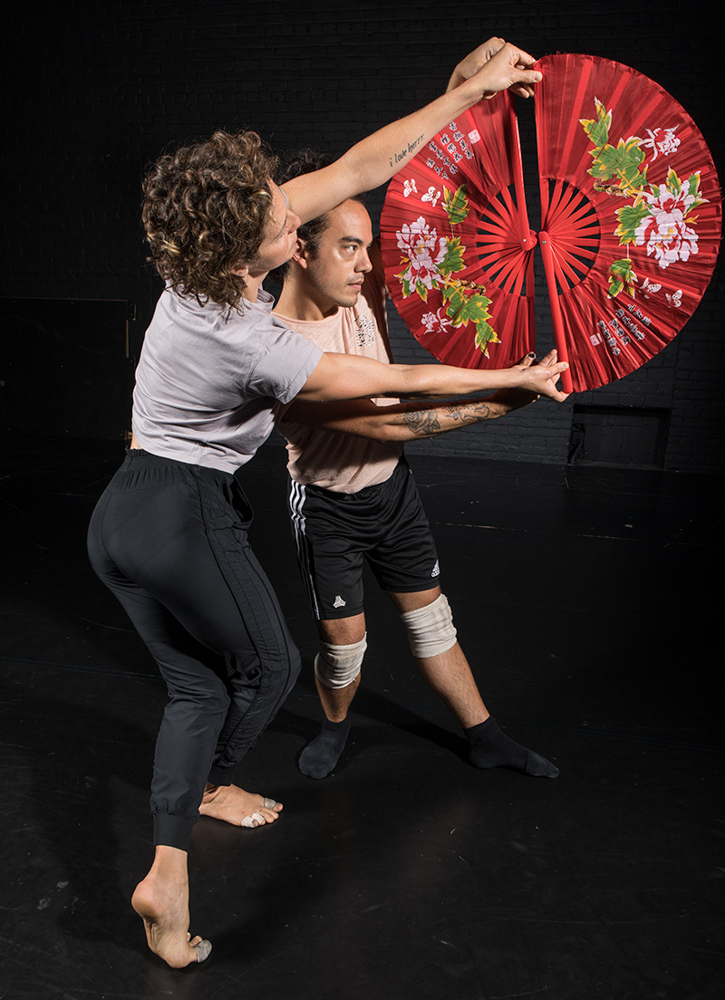DANCEworks Presents Doug Elkins’s ‘Kintsugi’
Performance Is Full of Relentless Imaginative Variations

With the big loading door to Anacapa Street open, daylight streams onto the Lobero Theatre stage in a massive vertical shaft that stretches from the floor to the fly loft. It’s not something you would generally see during a performance (there are more effective ways to light a stage, especially at night), but it’s the look for much of the time during rehearsals for DANCEworks, the extraordinary choreographic residency program founded by Dianne Vapnek that’s celebrating its 10-year anniversary this weekend. Unique in the dance world, DANCEworks offers contemporary choreographers the luxury of developing and rehearsing a new piece on the stage where it will be performed. Like the daylight pouring in on the rehearsing performers every afternoon during their residency, DANCEworks has illuminated the contemporary dance scene from a fresh angle and lit up a remarkable series of projects until they shine with daring and ingenuity.
This season’s DANCEworks performances take place on Friday and Saturday, September 7 and 8, and they promise to be among the most memorable to date, as they include not only an intriguing new work, Kintsugi, by acclaimed choreographer and DANCEworks alum Doug Elkins, but also a second act that will feature short solos by every one of the 10 artists who have participated in the series since it began in 2009. This remarkable confluence of talent is not something that audiences anywhere else will ever get to see.

Thanks to Vapnek’s steadfast determination and to the intense loyalty her critical patronage has elicited from these artists over the years, the Lobero audience will witness a program that will only happen here.
Embracing the Breaks
As a young man growing up in New York City during the birth of hip-hop, Doug Elkins was present at the creation of what has become the world’s most popular style of dance. Accepted by crews such as the Magnificent Force as a genuine B-boy (meaning break-boy, or breakdancing boy), Elkins originally honed his dance skills alongside guys with names like Icey Ice and Mr. Wiggles. When a 1982 summer internship at Massachusetts’s modern dance mecca Jacob’s Pillow granted him access to the full range of contemporary choreography, Elkins began playing with hybrid forms and learning new disciplines. At the same time that Elkins was developing his own idiosyncratic postmodern style, breaking, which began as the underground movement language of a few thousand people in the South Bronx, was spreading from New York to Brazil, France, Japan, South Korea, Cambodia, and beyond.
Although hip-hop dance quickly became the basis for the stage choreography of virtually all pop stars, in the rarefied world of modern dance performance and “serious” choreography, its acceptance was slower and more complex. Dance historians today largely credit Elkins, who launched the Doug Elkins Dance Company in 1988, with engineering that breakthrough. Through a magpie creative process, Elkins opened modern dance and ballet forms up to multiple other types of movement, drawing not only on his experience as a B-boy but also on his knowledge of martial arts such as capoeira and aikido. The title of an early Elkins piece reflects the playful complexity of his innovative and influential point of view. His 1992 Where Was Yvonne Rainer When I Had Saturday Night Fever name checks one of dance’s most rigorous experimentalists while insisting on the validity and relevance of funky social dance in its most commercially objectified form — classic disco.

In a career studded with awards and draped in accolades, two major works stand out. Fräulein Maria takes songs from the musical The Sound of Music and runs them through a dance-style blender. Breaking, capoeira, and voguing all make appearances as Elkins develops his implicit theses about dance — it’s an unparalleled form of direct emotional expression — and about the film’s central character, Maria, who is a kind of trickster playfully subverting the patriarchal family into which she has been thrown. Besides being frequently hilarious, Fräulein Maria packs an awesome cultural punch. Like John Coltrane’s hypnotic soprano sax deconstruction of “My Favorite Things,” Elkins’s work apprehends the inner strength of The Sound of Music by translating it into another language — in this case, that of street dance.
Emboldened by the success of his Fräulein and empowered by one of the earliest DANCEworks residency commissions, in 2011, Elkins created his most ambitious work to date right here in Santa Barbara on the Lobero stage. Mo(or)town/Redux, a retelling of William Shakespeare’s Othello scored to classic soul cuts from the 1960s, marries Elkins’s deep affection for the music to an even deeper desire to reveal the bittersweet complexities that lurk beneath its seductive surface. Using modern master José Limón’s classic 1949 ballet The Moor’s Pavane as a jumping-off place, Elkins and his dancers turned popular songs such as Otis Redding’s “Try a Little Tenderness” into moody, ambivalent representations of unresolved feelings and desperate states of mind.
The Japonization of Doug Elkins
In Kintsugi, Elkins draws again on his knowledge of and feeling for African-American music with “Don’t Let Me Be Misunderstood” by the great Nina Simone, but he does so in the service of a concept he gleaned while visiting Dan and Dianne Vapnek at their home in Kyoto. “Kintsugi” is the Japanese term for what happens when a broken object is not merely mended but improved by the mending. It derives from Japan’s rich symbolic culture around ceramics and specifically references the practice of repairing broken cups, bowls, and pitchers with a paste mixed with gold dust so that they glow and draw attention to the place where the object was once shattered.
For Elkins, the concept of kintsugi adds yet another layer to his constantly evolving personal philosophy of artistic collaboration, which he recently summed up this way: “Collaboration is tending to a strange, fucked-up garden. My intention is to create in that garden no more order than it needs. I hope that people will see what we’re doing as a landscape and feel free about paying attention to whatever draws their eye at any given moment.” His sentiments echo those of another 21st-century choreographer who has pushed the boundaries of the form, Akram Khan, who said recently that he is “actually striving for imperfection.” “I really push the dancers to be perfect,” said Khan, “and because I push them to the limit, they make mistakes, and when they make a mistake, I get them to leave it in.” Like Khan, Elkins is interested in the wild weirdness that erupts when performers embrace imperfections, the chemistry of what he describes as “collisions between experts and beginners.”
At a recent rehearsal for Kintsugi, Elkins and his six dancers — Donnell Oakley, Cori Marquis, rehearsal director Carolyn Cryer, Alexander “Lex” Dones, Eric Parra, and Elias Rosa — used bright-red fans to signal the work’s alliance to its culture of origin and to add unexpected auditory and visual effects to an eclectic mix of other influences. On August 24, at the popular Friday Club open rehearsal feature of the DANCEworks program, subscribers heard the percussive snapping of those red fans amid a whirlwind of extended contemporary dance technique, including lots of complex “threading” sequences in which dancers clasp hands while twisting and turning over, around, and through one another’s arms and legs. Company newcomers Parra and Rosa showed off super dynamics as they flowed through multiple styles, while longer-term members of the crew, such as Dones and Oakley, delivered the kind of relentless imaginative variations that are the company’s lifeblood.

Whether it’s on larger ensemble pieces such as the sextet he’s set to Nina Simone or in a loony little jig of a duet such as the piece he’s created for a song by The Magnetic Fields’ Stephin Merritt, Elkins throws off ideas like sparks, lightning bolts of gold zigzagging through the broken world. To see how these fragments come together, make your way to the Lobero for DANCEworks this weekend.
4•1•1
DANCEworks presents A Decade of Dance, featuring Doug Elkins Choreography, etc. plus a special 10-year retrospective, Friday-Saturday, September 7-8, at 8 p.m., at the Lobero Theatre (33 E. Canon Perdido St.). Call (805) 963-0761 or see lobero.org.
Read more:



